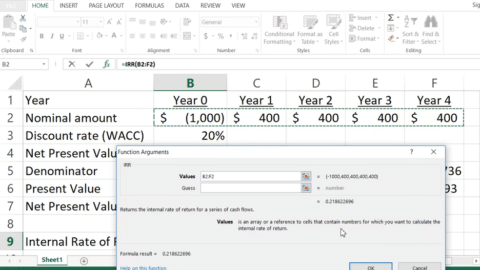Count Cells By Color in Excel: How to Use It?
Count Cells By Color in Excel: How to Use It? Excel is a powerful tool that provides various functions to help you analyze and present your data. One of the most useful features is the ability to count cells by color. This function allows you to quickly analyze data based on the cell color, providing you with insights into the data set that may not be readily apparent. In this article, we will show you how to use this function to your advantage.
Table of Contents
Step-by-Step Guide to Count Cells by Color
1. Manually Counting Cells by Color
You can manually count cells by color using the Find and Replace tool in Excel. This method is ideal for small data sets. To do this, follow these steps:
- Open the workbook that contains the cells you want to count.
- Press Ctrl + F to open the Find and Replace dialog box.
- Click on the Find tab, and then click on the Format button.
- Choose the color you want to count from the Fill tab in the Format Cells dialog box.
- Click OK to close the Format Cells dialog box.
- Click on Find All in the Find and Replace dialog box.
- Excel will display a list of all the cells with the selected color. Count the number of cells listed.
2. Using a VBA Macro to Count Cells by Color
A more efficient way to count cells by color, especially for large data sets, is to use a VBA Macro. Here is a step-by-step guide on how to use a VBA Macro to count cells by color:
- Press Alt + F11 to open the Visual Basic for Applications (VBA) Editor.
- Click on Insert in the menu bar, then select Module to create a new module.
- Copy and paste the following VBA code into the module:
- Close the VBA Editor.
- In Excel, select an empty cell where you want to display the count of cells by color.
- Type
=CountCellsByColor(A1,B2:B20)into the selected cell. ReplaceA1with the cell that has the color you want to count andB2:B20with the range of cells you want to count. - Press Enter to run the VBA Macro, and Excel will display the count of cells with the specified color in the selected cell.
PDF: Count Cells By Color in Excel
3. Using Conditional Formatting and COUNTIF Function
Another way to count cells by color is by using Conditional Formatting and the COUNTIF function. Here’s how:
- Select the range of cells you want to count.
- Go to Home > Conditional Formatting > New Rule.
- Choose Format cells that contain, and set the rule to format cells with the color you want to count.
- Click Format, choose the desired color, and click OK.
- Click OK again to apply the conditional formatting rule.
- In an empty cell, type the formula
=COUNTIF(A1:A10,"*"), replacingA1:A10with the range of cells you want to count. - Press Enter, and Excel will display the count of cells with the specified color.
Conclusion
Counting cells by color in Excel is a useful feature that can help you analyze data more effectively. By using the methods outlined in this article, you can quickly and easily count cells by color, whether you are working with small or large data sets. We hope this guide has been helpful in demonstrating how to count cells by color in Excel. If you have any questions or need further assistance, feel free to reach out to us.
Frequently Asked Questions
1. Can I count cells by multiple colors in Excel?
You can count cells by multiple colors in Excel using the COUNTIF function with multiple criteria. For example, to count cells that are green or red, you would use the following formula:
=COUNTIF(A1:A10,3)+COUNTIF(A1:A10,2)
2. Is there a limit to the number of colors I can use to format cells in Excel?
No, there is no limit to the number of colors you can use to format cells in Excel. However, using too many colors can make it difficult to analyze your data effectively. It is generally recommended to use a limited number of colors to highlight important data points or to differentiate between different types of data.
3. Can I use conditional formatting to count cells by color in Excel?
Yes, you can use conditional formatting to highlight cells based on their color in Excel. However, this method does not allow you to count cells by color. To count cells by color, you will need to use a combination of functions and formulas, as outlined in this article.
4. Does the formula to identify cell colorwork with custom colors in Excel?
Yes, the formula to identify cell color in Excel works with custom colors as well as standard colors. The formula will return a number corresponding to the cell’s RGB color value, regardless of whether the color is standard or custom.
5. Can I automate the process of counting cells by color in Excel?
Yes, you can automate counting cells by color in Excel using macros or Visual Basic for Applications (VBA) code. This can be a useful solution for analyzing large data sets or for performing repetitive tasks. However, it requires some programming knowledge and may not be suitable for all users.
You can read How to Control Charts in Excel: A Comprehensive Guide to learning more about Excel. You can also check the other content.
Hello, I’m Cansu, a professional dedicated to creating Excel tutorials, specifically catering to the needs of B2B professionals. With a passion for data analysis and a deep understanding of Microsoft Excel, I have built a reputation for providing comprehensive and user-friendly tutorials that empower businesses to harness the full potential of this powerful software.
I have always been fascinated by the intricate world of numbers and the ability of Excel to transform raw data into meaningful insights. Throughout my career, I have honed my data manipulation, visualization, and automation skills, enabling me to streamline complex processes and drive efficiency in various industries.
As a B2B specialist, I recognize the unique challenges that professionals face when managing and analyzing large volumes of data. With this understanding, I create tutorials tailored to businesses’ specific needs, offering practical solutions to enhance productivity, improve decision-making, and optimize workflows.
My tutorials cover various topics, including advanced formulas and functions, data modeling, pivot tables, macros, and data visualization techniques. I strive to explain complex concepts in a clear and accessible manner, ensuring that even those with limited Excel experience can grasp the concepts and apply them effectively in their work.
In addition to my tutorial work, I actively engage with the Excel community through workshops, webinars, and online forums. I believe in the power of knowledge sharing and collaborative learning, and I am committed to helping professionals unlock their full potential by mastering Excel.
With a strong track record of success and a growing community of satisfied learners, I continue to expand my repertoire of Excel tutorials, keeping up with the latest advancements and features in the software. I aim to empower businesses with the skills and tools they need to thrive in today’s data-driven world.
Suppose you are a B2B professional looking to enhance your Excel skills or a business seeking to improve data management practices. In that case, I invite you to join me on this journey of exploration and mastery. Let’s unlock the true potential of Excel together!
https://www.linkedin.com/in/cansuaydinim/






![Mastering VBA ReDim: VBA ReDim Cheat Sheet PDF! [2024]](https://www.projectcubicle.com/wp-content/uploads/2024/03/Mastering-VBA-ReDim-VBA-ReDim-Cheat-Sheet-PDF-2024-480x270.png)




I tried to use this to count cells that have been filled with red, yellow, or green but when I use the “color” function, according to Microsoft, this function returns “The value 1 if the cell is formatted in color for negative values; otherwise returns 0 (zero).” so it’s looking at the number format, not the cell fill color. I’ve searched to see if there is a different function to use but can’t find one – some people have written VBA. Can you shed any light?
I can fix it.